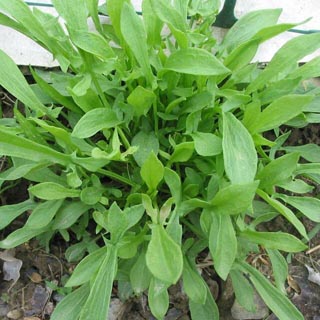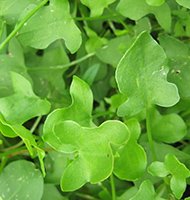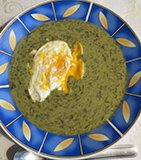Sorrel Nutrition facts
Sorrel, particularly French sorrel (also popular as buckler leaf sorrel), is one of the most sought-after greens in the Mediterranean region.
Binomially, it belongs to the Polygonaceae family of plant species that also includes common sorrel, patience dock, buckwheat, etc.
Scientific name: Rumex scutatus (Buckler leaf type).
R. scutatus is found in the wild in many parts of northern Asia and Europe. It grows well under a variety of soil conditions ranging from sandy to loamy soils, but profusely under well-drained, moist, sandy soils.

|
| Sorrel-broadleaf (Rumex acetosa). Note elongated, broad leaves. Photo courtesy- HooksgreenHerbs.com |

|
| Sorrel-buckler leaf (R. scutatus). Note for a shield-like green leaves. Photo courtesy-HooksgreenHerbs.com |
There are two principal varieties of sorrel grown as a potherb. Common sorrel or "Garden sorrel" (Rumex acetosa) has large, deep-veined, elongated arrow-like tender leaves. French sorrel (Rumex scutatus) has flat, shield-shaped, less acidic leaves. The other uncommon type is R. sanguineus or red-veined sorrel
The plant grows to about 2 feet in height in clumps with pink flowers in racemose appearing during early summer.
R. scutatus is frequently used as potherb for its nutritious, less oxalic acid leaves across Western Europe and in the Americas. Trim flowering spikes as they appear for a better green harvest.
Health benefits of Sorrel
Sorrel is packed with health-benefiting phytonutrients, fiber, vitamins, and minerals.
Sorrel leaves carry very low calories(100 g of raw leaves provide just 22 calories). Its leaves hold a good amount of soluble dietary fiber.
100 grams of fresh sorrel has 48 mg of vitamin C (80% of daily recommended levels of vitamin C). Vitamin C is a powerful antioxidant that helps the human body develop resistance against infectious agents and scavenge harmful oxygen-free radicals.
100 grams of fresh sorrel carry 4000 IU of vitamin A (about 133% of RDA). It is required for maintaining healthy mucosa and skin and is essential for normal eyesight. Consumption of natural vegetables and fruits rich in vitamin A and flavonoids is also known to help the human body protect from lung and oral cavity cancers.
In addition to vitamins, fresh leaves are also a rich source of several vital antioxidant phenolic antioxidants like kaempferol, myricetin, quercetin,, etc. Together, these compounds help act as protective scavengers against oxygen-derived free radicals and reactive oxygen species (ROS) and play a healing role in aging and various disease processes.
Further, it also holds a good amount of many B-complex vitamins such as vitamin-B6 (pyridoxine), riboflavin, thiamin (vitamin B-1), and niacin.
Sorrel leaves also contain a good amount of minerals like manganese, calcium, potassium, magnesium, copper, and zinc. Potassium is an important component of cells and body fluids that helps control heart rate and blood pressure. The body uses manganese and copper as a cofactor for the antioxidant enzyme, superoxide dismutase.
| Principle | Nutrient Value | Percent of RDA |
|---|---|---|
| Energy | 22 Kcal | 1% |
| Carbohydrates | 3.20 g | 2.5% |
| Protein | 2.00 g | 3.5% |
| Total Fat | 0.7 g | 3% |
| Cholesterol | 0 mg | 0% |
| Dietary Fiber | 2.9 g | 7.5% |
| Vitamins | ||
| Folates | 13 µg | 4% |
| Niacin | 0.500 mg | 3% |
| Pantothenic acid | 0.041 mg | 1% |
| Pyridoxine | 0.122 mg | 9% |
| Riboflavin | 0.100 mg | 8% |
| Thiamin | 0.040 mg | 3% |
| Vitamin A | 4000 IU | 133% |
| Vitamin C | 48 mg | 80% |
| Electrolytes | ||
| Sodium | 4 mg | <1% |
| Potassium | 390 mg | 8% |
| Minerals | ||
| Calcium | 44 mg | 4% |
| Copper | 0.131 mg | 14% |
| Iron | 2.40 mg | 30% |
| Magnesium | 103 mg | 26% |
| Manganese | 0.349 mg | 21% |
| Zinc | 0.20 mg | 2% |
| Phyto-nutrients | ||
| Kaempferol | 10.3 mg | -- |
| Myrcetin | 5.7 mg | -- |
| Quercetin | 86.2 µg | -- |
Selection and storage
Although sorrel can be available around the year, it is at its best during spring to early summer. Inside Europe, fresh sorrel is available from March until September. In the farmer's market choose firm, shiny green leaves with the thin petiole. Avoid yellow, wilted, large leaves with prominent veins.
Like any other greens, wash sorrel clumps thoroughly in clean running water and rinse them in salt water for about 30 minutes in order to remove dirt and any insecticide residues.
Fresh herbs should be used early to get maximum nutrition. To store, keep wrapped in a damp towel and place in the refrigerator for extended use (up to 3 days).
Preparation and serving methods
To prepare, wash fresh leaves in cold water. Gently pat them dry using a tissue or soft cloth. Trim away any thick petioles.
Sorrel can be eaten raw or cooked. Its acidic, lemony-tang greens are refreshing additions to salads and soups. Young tender leaves are preferred in salads and sandwiches. Large leaves can be cooked and prepared in the same way as spinach or cress.

|
| Garden sorrel soup with eggs. Photo courtesy-Sikeri (flickr.com) |
Here are some serving tips:
Sorrel is delicious in soups and sauces. Sorrel soup (green soup/borscht) is a classic dish in many East-European countries, particularly in Poland where it is a national soup dish. Traditionally, it is served with a quartered boiled egg and a heap of sour cream to neutralize the acidic taste.
Sorrel sauce/paste/pesto is a traditional accompaniment to salmon, halibut, arctic char, and pike in classic French cuisine. It also blends well with veal, poultry, and lamb.
It can be mixed with other greens like spinach with pulses and vegetables.
Add fresh, chopped leaves to Italian favorites like pasta, risotto, etc.
Safety profile
Sorrel leaves and stems contain oxalic acid. Oxalic acid is an anti-nutrition compound found naturally in many vegetables and greens. High oxalate levels in the diet prevent absorption of minerals like calcium, magnesium, etc. Cooking in boiling water removes this compound to a great extent. Adding sour cream and milk chelates oxalic acid and prevents its absorption into the blood. People with known oxalate kidney stone disease may want to avoid vegetables high in oxalates. Adequate intake of water is therefore advised to maintain normal urine output. (Medical disclaimer).
≺≺ Back to Vegetables from Sorrel. Visit here for an impressive list of vegetables with complete illustrations of their nutrition facts and health benefits.
≺≺ Back to Home page.
Further reading:
Refer Vegetable information page - University of Illinois Extension. (Link opens in new window).
USDA National Nutrient Database.(Link opens new window)